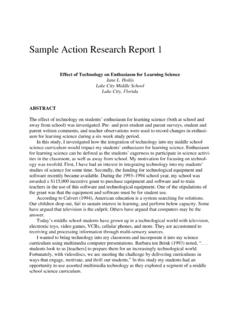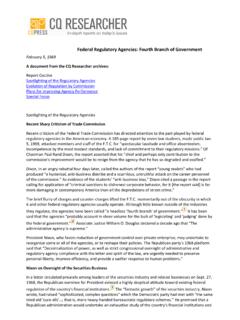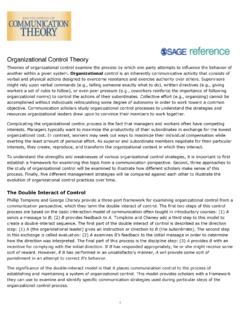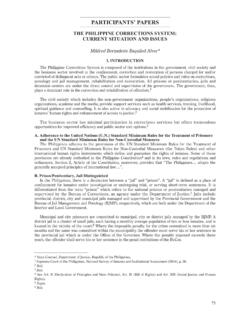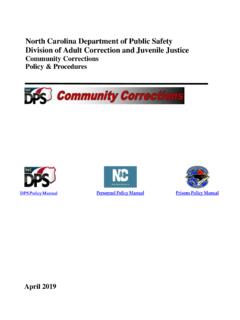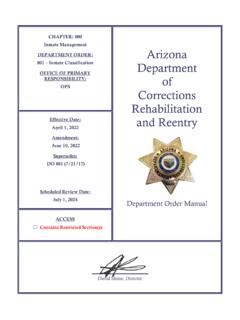Transcription of Corrections Gangs and Violence in Prisons
1 CorrectionsGangs and Violence in PrisonsContributors: M. Levan KristineEditors: William J. ChamblissBook Title: CorrectionsChapter Title: " Gangs and Violence in Prisons "Pub. Date: 2011 Access Date: December 09, 2014 Publishing Company: SAGE Publications, : Thousand OaksPrint ISBN: 9781412978569 Online ISBN: 9781412994101 DOI: pages: 105-119 2011 SAGE Publications, Inc. All Rights PDF has been generated from SAGE knowledge. Please note that the paginationof the online version will vary from the pagination of the print 2011 SAGE Publications, Inc.
2 All Rights knowledgePage 3 of 18 Corrections : Gangs and Violence in [p. 105 ]Chapter 8: Gangs and Violence in PrisonsThere are various definitions for prison Gangs , but a generally accepted descriptionis that a prison gang operates within the prison system as a criminally oriented entitythat threatens, or is perceived to threaten, the orderly management of a belonging to a prison gang will often have similar norms, values, and languageand have a distinct code of conduct among its members. Many prison officials usethe term security threat group (STG) to identify a gang.
3 Prison Gangs are usuallyinformally organized along racial or ethnic lines, mimicking and often overlapping theorganization of street Gangs . Inmates often join Gangs as either a means to securepersonal protection from other inmates or for economic gain, often relying on gangmembers as surrogate family prisoners, Violence is often a means by which to gain status from other inmates,and Gangs provide both a means to perpetuate this Violence and protection from eitherunaffiliated prisoners or from rival gang members. Some forms of prison violenceinclude assault, sexual assault, riots, and homicide.
4 Much of the Violence that occursin prison remains unreported, making it difficult to address on an individual victim [p. 106 ] facilities often use various types of segregation techniques toreduce or punish different forms of Violence . They may also rely on education on bothgangs and Violence in an effort to reduce their of Prison GangsMost prison Gangs are based on an inmate'race and ethnicity. Some white gangsinclude the Aryan Brotherhood, Hell'Angels, and Dirty White Boys. African Americangangs include members belonging to the Crips, the Bloods, the Vice Lords, the , and the Black Guerrilla Family.
5 Some Hispanic and Latino Gangs include theMexican Mafia, La Nuestra Familia, and the Latin Kings. Although a few multiracialprison Gangs exist, members belonging to Gangs that are not organized primarily bySAGE 2011 SAGE Publications, Inc. All Rights knowledgePage 4 of 18 Corrections : Gangs and Violence in Prisonsrace are often organized to engage almost exclusively in economic endeavors, such asdrug of the existing prison Gangs began as street Gangs that formed in the example, the Hell'Angels, the Crips, and the Bloods have existed for decadesin the free community .
6 The United States began to use incarceration as its primarymechanism of punishment for Gangs , and the gang population behind bars began tosurge. As members of these street Gangs became incarcerated, they began to formgangs using similar structures while they were incarcerated, importing many of theirbeliefs, values, and norms and assimilating them into their prison environments. Asprisoners transfer between facilities, they may extend existing gang membership intonew chapters. This not only increases membership, but also may create rivalries amongthe various chapters and gang affiliations.
7 Depending on the security level of the facility,gang members may comprise as much as one-third of the total inmate facilities typically report the highest levels of gang membership, whileminimum-security Prisons have the lowest levels. The number of inmates involved ingangs also varies according to geographical location, with New Mexico, Texas, andCalifornia reporting the greatest number of gang MembershipBecause Prisons specifically prohibit gang membership, many members of prison gangsattempt to conceal their gang affiliation and activities.
8 Many of the solutions to dealingwith gang activities are punitive, such as placing known gang members in administrativesegregation. As such, it is unclear [p. 107 ] as to the exact number of inmates whoare affiliated with a gang. There are currently more than 100 known prison gangsthroughout the United many prison Gangs engage in similar types of activities, each gang is uniqueand tries to differentiate itself from other rival Gangs . They often have a unique motto,specific membership symbols, colors, and a constitution that dictates group often have a hierarchical structure, with a leader and a council of members whowork directly under the appointed leader.
9 The structure of a prison gang is often morestable and more organized than that of a typical street gang, in part because thereSAGE 2011 SAGE Publications, Inc. All Rights knowledgePage 5 of 18 Corrections : Gangs and Violence in Prisonstends to be less turnover of gang members in a prison gang than a street gang. Bothrequire absolute loyalty to one'gang, as well as complete secrecy of affiliation with members often identify each other by tattoos of their particular gang tattoos may be made by either cutting into the skin, or by burning the skin withan iron.
10 Each gang typically has specific tattoos that are associated with its members,and nonmembers who falsely self-identify as a gang member may have their tattooforcibly removed by members of the gang. Most Prisons expressly prohibit tattooing, inpart because of gang affiliations, but also to curb transmission of diseases. However,inmates continue to tattoo themselves and each other and often hide the tattoos undertheir clothing. They may also carry scraps of paper with tattoolike emblems that arespecific to their gang for identification Gangs often adhere to the blood in-blood out adage, and are more difficult tomove in and out of than the average street gang.
